Polarization-Insensitive Broadband THz Absorber Based on Circular Graphene Patches
Abstract
1. Introduction
2. Design of Structure
3. Results and Discussion
4. Conclusions
Author Contributions
Funding
Data Availability Statement
Acknowledgments
Conflicts of Interest
References
- Tonouchi, M. Cutting-edge THz technology. Nat. Photonics 2007, 1, 97–105. [Google Scholar] [CrossRef]
- Nikoo, M.S.; Jafari, A.; Perera, N.; Zhu, M.; Matioli, E. Nanoplasma-enabled picosecond switches for ultrafast electronics. Nature 2020, 579, 534–539. [Google Scholar] [CrossRef]
- Delfanazari, K.; Klemm, R.A.; Joyce, H.J.; Ritchie, D.A.; Kadowaki, K. Integrated, portable, tunable, and coherent terahertz sources and sensitive detectors based on layered superconductors. Proc. IEEE 2020, 108, 721–734. [Google Scholar] [CrossRef]
- Siegel, P.H. Terahertz technology. IEEE Trans. Microw. Theory Tech. 2002, 50, 910–928. [Google Scholar] [CrossRef]
- Risacher, C.; Güsten, R.; Stutzki, J.; Hübers, H.; Büchel, D.; Graf, U.U.; Heyminck, S.; Honingh, C.E.; Jacobs, K.; Klein, B. First supra-THz heterodyne array receivers for astronomy with the SOFIA observatory. IEEE Trans. Terahertz Sci. Technol. 2016, 6, 199–211. [Google Scholar] [CrossRef][Green Version]
- Lee, S.W. Scattering by dielectric-loaded screen. IEEE Trans. Antennas Propag. 1971, 19, 656–665. [Google Scholar]
- Woodward, R. Terahertz pulse imaging in reflection geometry of human skin cancer and skin tissue. Phys. Med. Biol. 2002, 47, 3853–3863. [Google Scholar] [CrossRef]
- Ajito, K. Terahertz spectroscopy for pharmaceutical and biomedical Applications. IEEE Trans. Terahertz Sci. Technol. 2015, 5, 1140–1145. [Google Scholar]
- Federici, J.; Moeller, L. Review of terahertz and subterahertz wireless communications. J. Appl. Phys. 2010, 107, 6–323. [Google Scholar] [CrossRef]
- Zeng, H.; Zhang, Y.; Lan, F.; Liang, S.; Wang, L. Terahertz dual-polarization beam splitter via an anisotropic matrix metasurface. IEEE Trans. Terahertz Sci. Technol. 2019, 9, 491–497. [Google Scholar] [CrossRef]
- Zhao, Y.; Wang, L.; Zhang, Y.; Qiao, S.; Yang, Z. High-speed efficient terahertz modulation based on tunable collective-individual state conversion within an active 3 nm two-dimensional electron Gas metasurface. Nano Lett. 2019, 19, 7588–7597. [Google Scholar] [CrossRef]
- Cui, T.J.; Li, L.; Liu, S.; Ma, Q.; Cheng, Q. Information metamaterial systems. iScience 2020, 23, 101403. [Google Scholar] [CrossRef]
- He, J.; Xie, Z.; Sun, W.; Wang, X.; Ji, Y.; Wang, S.; Yuan, L.; Yan, Z. Terahertz tunable metasurface lens based on vanadium dioxide phase transition. Plasmonics 2016, 11, 1285–1290. [Google Scholar] [CrossRef]
- Landy, N.I.; Bingham, C.M.; Tyler, T.; Jokerst, N.; Smith, D.R.; Padilla, W.J. Design, theory, and measurement of a polarization insensitive absorber for terahertz imaging. Phys. Rev. B Condens. Matter Mater. Phys. 2008, 79, 98–103. [Google Scholar] [CrossRef]
- Wilbert, D.S.; Hokmabadi, M.P.; Martinez, J. Terahertz metamaterials perfect absorbers for sensing and imaging. Proc. SPIE 2014, 8585, 85850Y. [Google Scholar]
- Carranza, I.E.; Grant, J.; Gough, J.; Cumming, D. Uncooled CMOS terahertz imager using a metamaterial absorber and pn diode. Opt. Lett. 2016, 41, 3261–3264. [Google Scholar]
- Bosquespadilla, F.J.; Landy, L.N.; Smith, W.K.; Smith, J.D.; Padilla, E.; Sajuyigbe, S.; Mock, D.J. Perfect metamaterial absorber. Phys. Rev. Lett. 2008, 100, 279–282. [Google Scholar]
- Chen, H.T. Interference theory of metamaterial perfect absorbers. Opt. Express 2012, 20, 7165–7172. [Google Scholar] [CrossRef] [PubMed]
- Wen, Q.Y.; Zhang, H.W.; Xie, Y.S.; Yang, Q.H.; Liu, Y.L. Dual band terahertz metamaterial absorber: Design, fabrication, and characterization. Appl. Phys. Lett. 2009, 95, 241111. [Google Scholar] [CrossRef]
- Yong, M.; Qin, C.; Grant, J.; Saha, S.C.; Cumming, D. A terahertz polarization insensitive dual band metamaterial absorber. Opt. Lett. 2011, 36, 945–947. [Google Scholar]
- Cheng, H.; Chen, S.; Yang, H.; Li, J.; An, X.; Gu, C.; Tian, J. A polarization insensitive and wide-angle dual-band nearly perfect absorber in the infrared regime. J. Opt. 2012, 14, 85102–85106. [Google Scholar] [CrossRef]
- Shen, X.; Cui, T.J.; Zhao, J.; Ma, H.F.; Hui, L. Polarization-independent wide-angle triple-band metamaterial absorber. Opt. Express 2011, 19, 9401–9407. [Google Scholar] [CrossRef]
- Pan, W.; Yu, X.; Zhang, J.; Zeng, W. A broadband terahertz metamaterial absorber based on two circular split rings. IEEE J. Quantum Electron. 2017, 53, 1–6. [Google Scholar] [CrossRef]
- Wen, Y.; Ma, W.; Bailey, J.; Matmon, G.; Yu, X. Broadband terahertz metamaterial absorber based on asymmetric resonators with perfect absorption. IEEE Trans. Terahertz Sci. Technol. 2015, 5, 406–411. [Google Scholar] [CrossRef]
- Wang, B.X.; Wang, L.L.; Wang, G.Z.; Huang, W.Q.; Zhai, X. Theoretical investigation of broadband and wide-angle terahertz metamaterial absorber. IEEE Photonics Technol. Lett. 2014, 26, 111–114. [Google Scholar] [CrossRef]
- Chen, H.T.; Padilla, W.J.; Zide, J.M.O.; Gossard, A.C.; Taylor, A.J.; Averitt, R.D. Active terahertz metamaterial devices. Nature 2006, 444, 597–600. [Google Scholar] [CrossRef]
- Okada, T.; Tanaka, K. Photo-designed terahertz devices. Sci. Rep. 2011, 1, 121. [Google Scholar] [CrossRef] [PubMed]
- Zhang, Y.; Qiao, S.; Sun, L.; Shi, Q.W.; Huang, W.; Li, L.; Yang, Z. Photoinduced active terahertz metamaterials with nanostructured vanadium dioxide film deposited by sol-gel method. Opt. Express 2014, 22, 11070–11078. [Google Scholar] [PubMed]
- Jeong, Y.G.; Bernien, H.; Kyoung, J.S.; Park, H.R.; Kim, H.S. Electrical control of terahertz nano antennas on VO2 thin film. Opt. Express 2011, 19, 21211–21215. [Google Scholar] [CrossRef] [PubMed]
- Gosciniak, J.; Tan, D. Theoretical investigation of graphene-based photonic modulators. Sci. Rep. 2013, 3, 1897. [Google Scholar] [CrossRef] [PubMed]
- Shi, S.F.; Zeng, B.; Han, H.L.; Hong, X.; Tsai, H.Z. Optimizing broadband terahertz modulation with hybrid graphene/metasurface structures. Nano Lett. 2015, 15, 372–377. [Google Scholar] [CrossRef]
- Geim, A.K.; Novoselov, K.S. The rise of graphene. Nat. Mater. 2007, 6, 183–191. [Google Scholar] [CrossRef]
- Koppens, F.H.L.; Chang, D.E.; de Abajo, F.J.G. Graphene plasmonics: A platform for strong light-matter Interactions. Nano. Lett. 2011, 11, 3370–3377. [Google Scholar] [CrossRef]
- He, X.Y.; Tao, J.; Meng, B. Analysis of graphene TE surface plasmons in the terahertz regime. Nanotechnology 2013, 24, 345203–345209. [Google Scholar] [CrossRef]
- Li, Z.Q.; Henriksen, E.A.; Jiang, Z.; Hao, Z.; Martin, M.C.; Kim, P.; Stormer, H.L.; Basov, D.N. Dirac charge dynamics in graphene by infrared spectroscopy. Nat. Phys. 2008, 4, 532–535. [Google Scholar] [CrossRef]
- Hanson, G.W. Dyadic Green’s functions for an anisotropic, non-local model of biased graphene. IEEE Trans. Antennas Propag. 2008, 56, 747–757. [Google Scholar] [CrossRef]
- Batrakov, K.; Kuzhir1, P.; Maksimenko1, S. Enhanced microwave-to-terahertz absorption in graphene. Appl. Phys. Lett. 2016, 108, 123101. [Google Scholar] [CrossRef]
- Lobet, M. Robust electromagnetic absorption by graphene/polymer heterostructures. Nanotechnology 2015, 26, 285702. [Google Scholar] [CrossRef] [PubMed]
- Alaee, R.; Farhat, M.; Rockstuhl, C.; Lederer, F. A perfect absorber made of a graphene micro-ribbon metamaterial. Opt. Express 2012, 20, 28017–28024. [Google Scholar] [CrossRef] [PubMed]
- Nikitin, A.Y.; Guinea, F.; Garcia-Vidal, F.J.; Martin-Moreno, L. Surface plasmon enhanced absorption and suppressed transmission in periodic arrays of graphene ribbons. Phys. Rev. B 2012, 85, 081405. [Google Scholar] [CrossRef]
- Ke, S.; Wang, B.; Huang, H.; Long, H.; Wang, K.; Lu, P. Plasmonic absorption enhancement in periodic cross-shaped graphene arrays. Opt. Express 2015, 23, 8888–8900. [Google Scholar] [CrossRef]
- Dong, Y.; Liu, P.; Yu, D.; Li, G.; Yang, L. A tunable ultra-broadband ultrathin terahertz absorber using graphene stacks. IEEE Antennas Wirel. Propag. Lett. 2016, 16, 40–44. [Google Scholar]
- Andryieuski, A.; Lavrinenko, A.V. Graphene metamaterials based tunable terahertz absorber: Effective surface conductivity approach. Opt. Express 2013, 21, 9144–9155. [Google Scholar] [CrossRef]
- Zhang, Y.; Feng, Y.; Zhu, B.; Zhao, J.; Jiang, T. Graphene based tunable metamaterial absorber and polarization modulation in terahertz frequency. Opt. Express 2014, 22, 22743–22752. [Google Scholar] [CrossRef]
- Chen, M.; Sun, W.; Cai, J.; Chang, L.; Xiao, X. Frequency-tunable terahertz absorbers based on graphene metasurface. Opt. Commun. 2017, 382, 144–150. [Google Scholar] [CrossRef]
- Su, Z.; Wang, Y.; Xin, L.; Hao, L.; Chao, Z.; Li, M.; Tian, S.; Yang, G. A tunable THz absorber consisting of an elliptical graphene disk array. Phys. Chem. Chem. Phys. 2018, 20, 14357–14361. [Google Scholar] [CrossRef] [PubMed]
- Wang, F.; Huang, S.; Li, L.; Chen, W.; Xie, Z. Dual-band tunable perfect metamaterial absorber based on graphene. Appl. Opt. 2018, 57, 6916–6922. [Google Scholar] [CrossRef] [PubMed]
- Li, Y.; Wu, J.; Wang, C.; Shen, Z.; Wu, D. Tunable broadband metamaterial absorber with single-layered graphene arrays of rings and discs in terahertz range. Phys. Scr. 2019, 94, 035703. [Google Scholar] [CrossRef]
- Ye, L.; Chen, X.; Cai, G.; Zhu, J.; Na, L.; Liu, Q. Electrically tunable broadband trahertz absorption with hybrid-patterned graphene metasurfaces. Nanomaterials 2018, 8, 562. [Google Scholar] [CrossRef]
- Ju, L.; Geng, B.; Horng, J.; Girit, C. Graphene plasmonics for tunable terahertz metamaterials. Nat. Nanotechnol. 2011, 6, 630–634. [Google Scholar] [CrossRef]
- Yan, H.; Li, X.; Chandra, B. Tunable infrared plasmonic devices using graphene/insulator stacks. Nat. Nanotechnol. 2012, 7, 330–334. [Google Scholar] [CrossRef]
- Mishra, R.; Sahu, A.; Panwar, R. Cascaded graphene frequency selective surface integrated tunable broadband terahertz metamaterial absorber. IEEE Photonics J. 2019, 11, 1–10. [Google Scholar] [CrossRef]
- Gusynin, V.P.; Sharapov, S.G.; Carbotte, J.P. Magneto-optical conductivity in graphene. J. Phys. Condens. Matter 2007, 19, 026222. [Google Scholar] [CrossRef]
- Hanson, G.W. Dyadic Green’s functions and guided surface waves for a surface conductivity model of graphene. J. Appl. Phys. 2008, 103, 064302. [Google Scholar] [CrossRef]
- Vakil, A.; Engheta, N. Transformation optics using graphene. Science 2011, 332, 1291–1294. [Google Scholar] [CrossRef] [PubMed]
- Xu, W.; Zhu, Z.H.; Liu, K.; Zhang, J.F.; Yuan, X.D.; Lu, Q.S.; Qin, S.Q. Toward integrated electrically controllable directional coupling based on dielectric loaded graphene plasmonic waveguide. Opt. Lett. 2015, 40, 1603–1606. [Google Scholar] [CrossRef] [PubMed]
- Ye, L.; Sui, K.; Liu, Y.; Zhang, M.; Huo, L.Q. Graphene-based hybrid plasmonic waveguide for highly efficient broadband mid-infrared propagation and modulation. Opt. Express 2018, 26, 15935–15947. [Google Scholar] [CrossRef] [PubMed]
- Liu, Y.; Huang, R.; Ouyang, Z. Terahertz absorber with dynamically switchable dual-broadband based on hybrid metamaterial with vanadium dioxide and graphene. Opt. Express 2021, 29, 20839–20850. [Google Scholar] [CrossRef]
- Ding, F.; Dai, J.; Chen, Y.; Zhu, J.; Jin, Y.; Bozhevolnyi, S.I. Broadband near-infrared metamaterial absorbers utilizing highly lossy metals. Sci. Rep. 2016, 6, 39445. [Google Scholar] [CrossRef]
- Xiao, B.; Gu, M.; Xiao, S. Broadband, wide-angle and tunable terahertz absorber based on cross-shaped graphene arrays. Appl. Opt. 2017, 56, 5458–5462. [Google Scholar] [CrossRef]

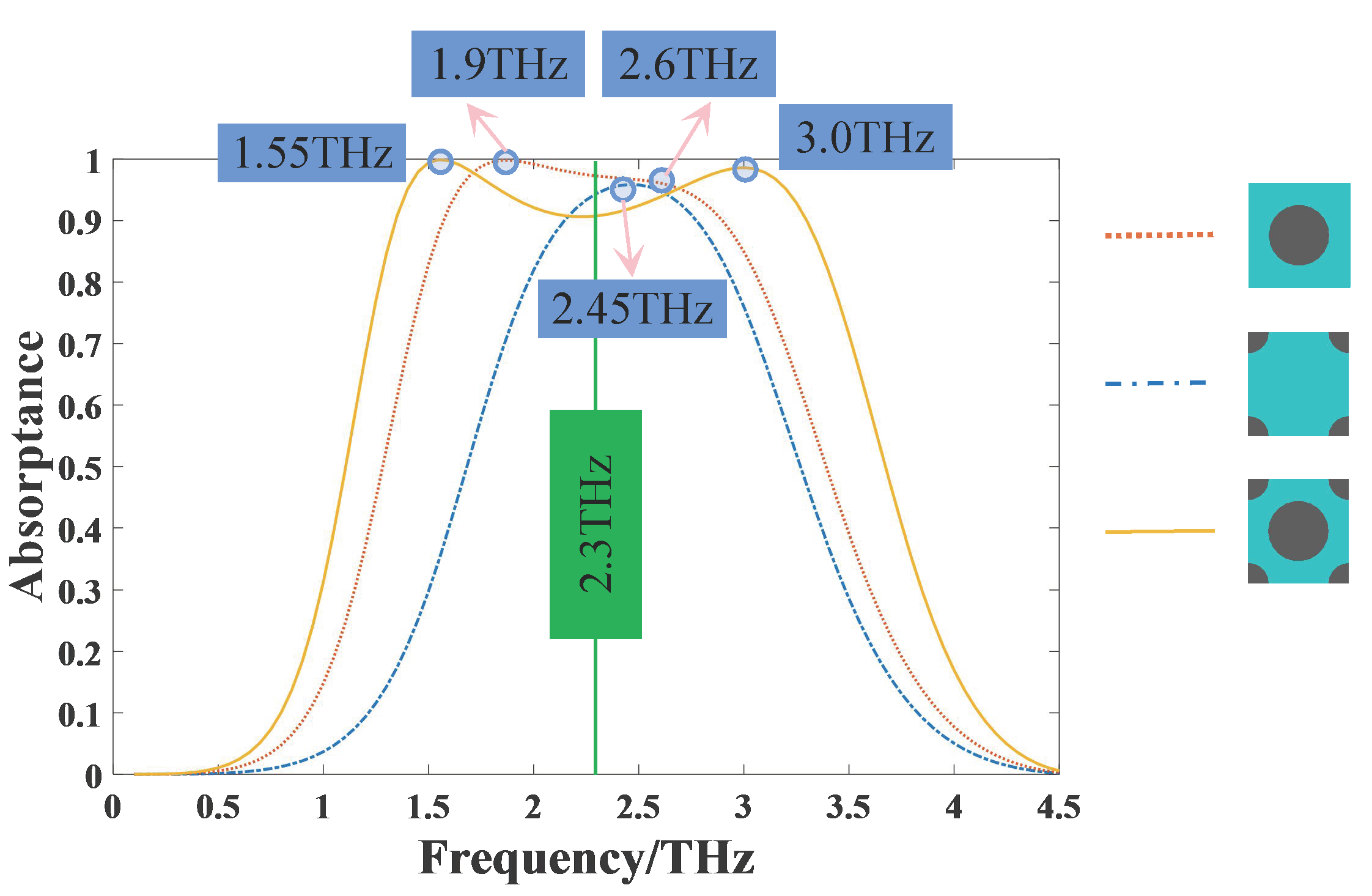
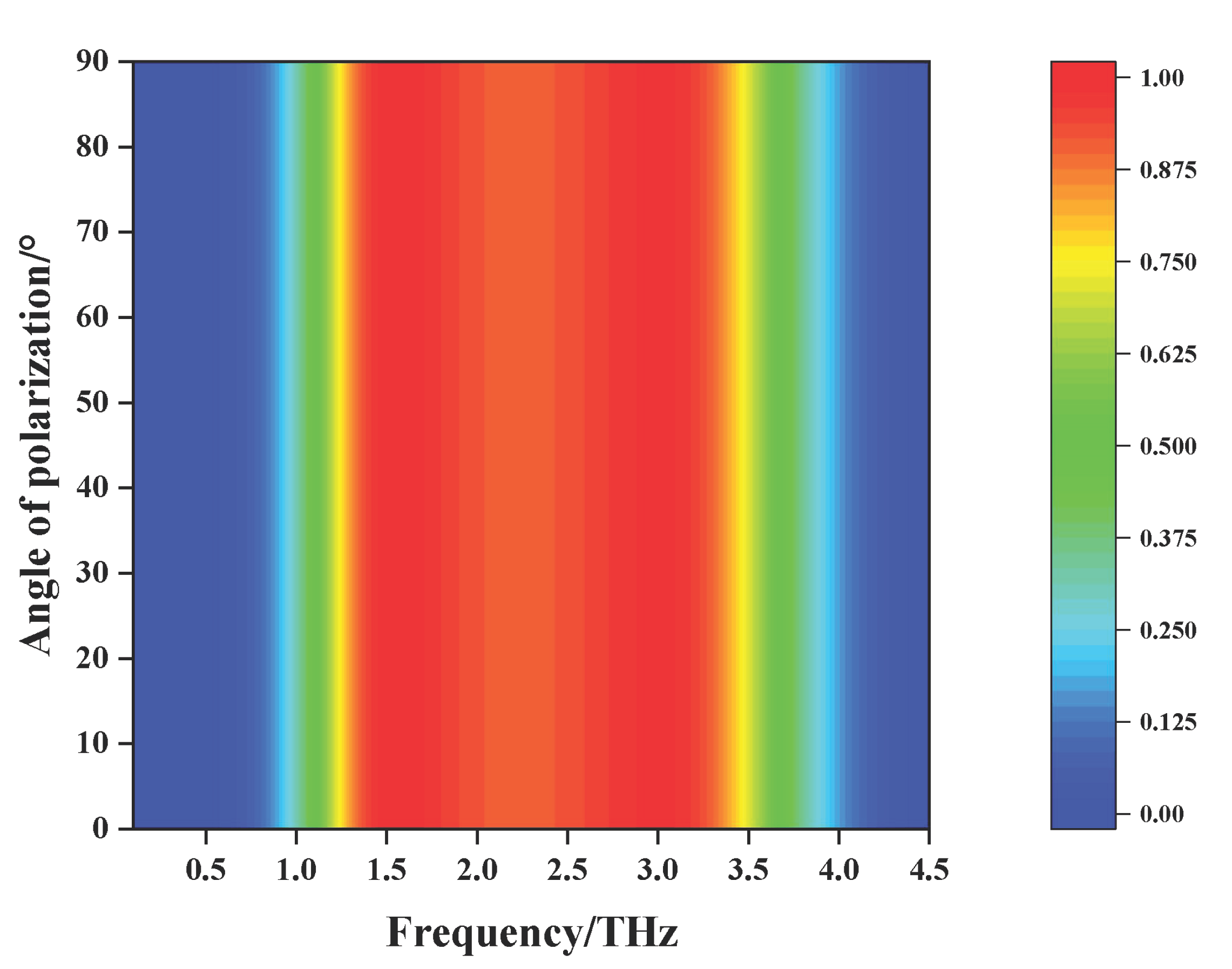
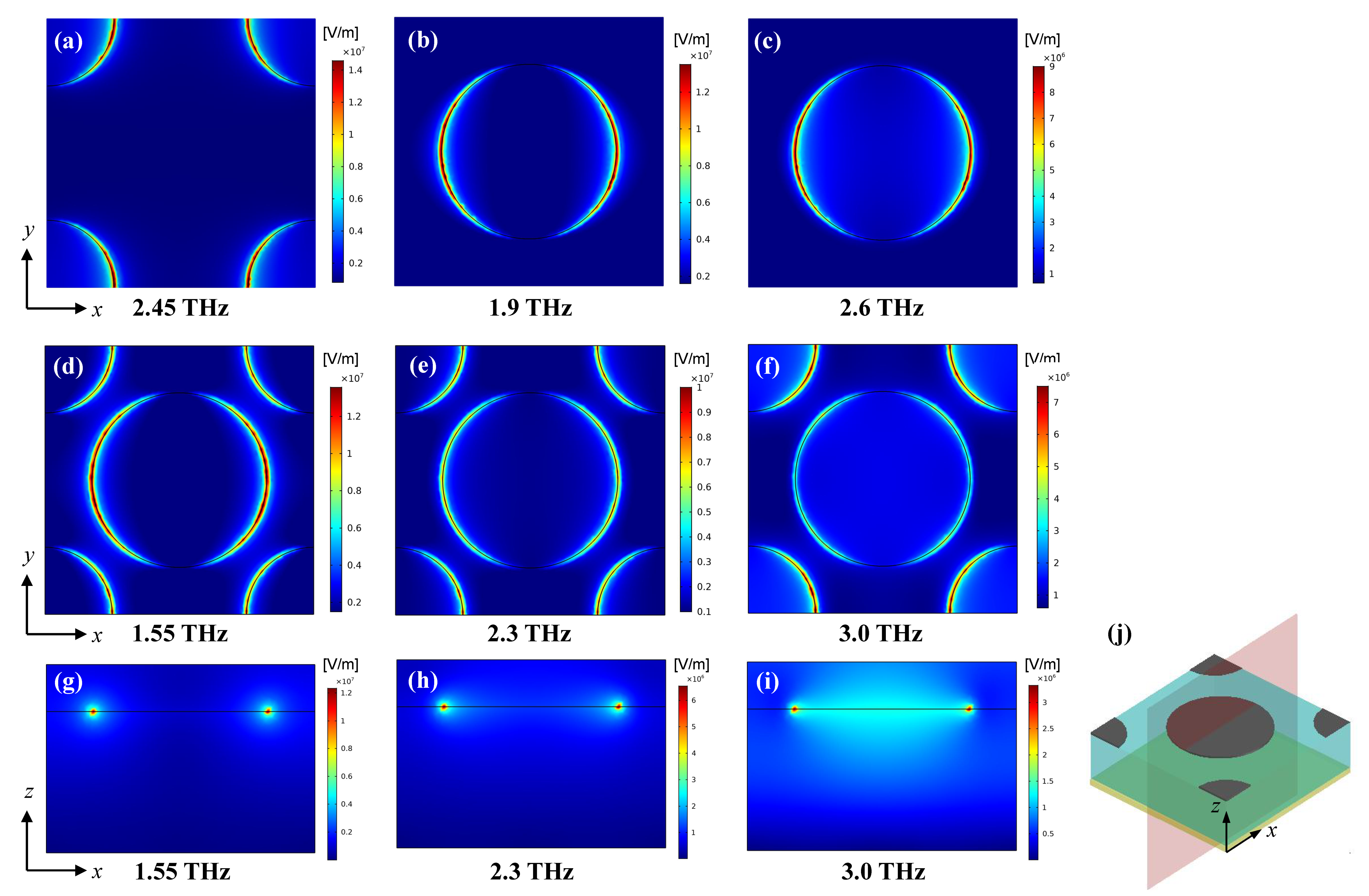
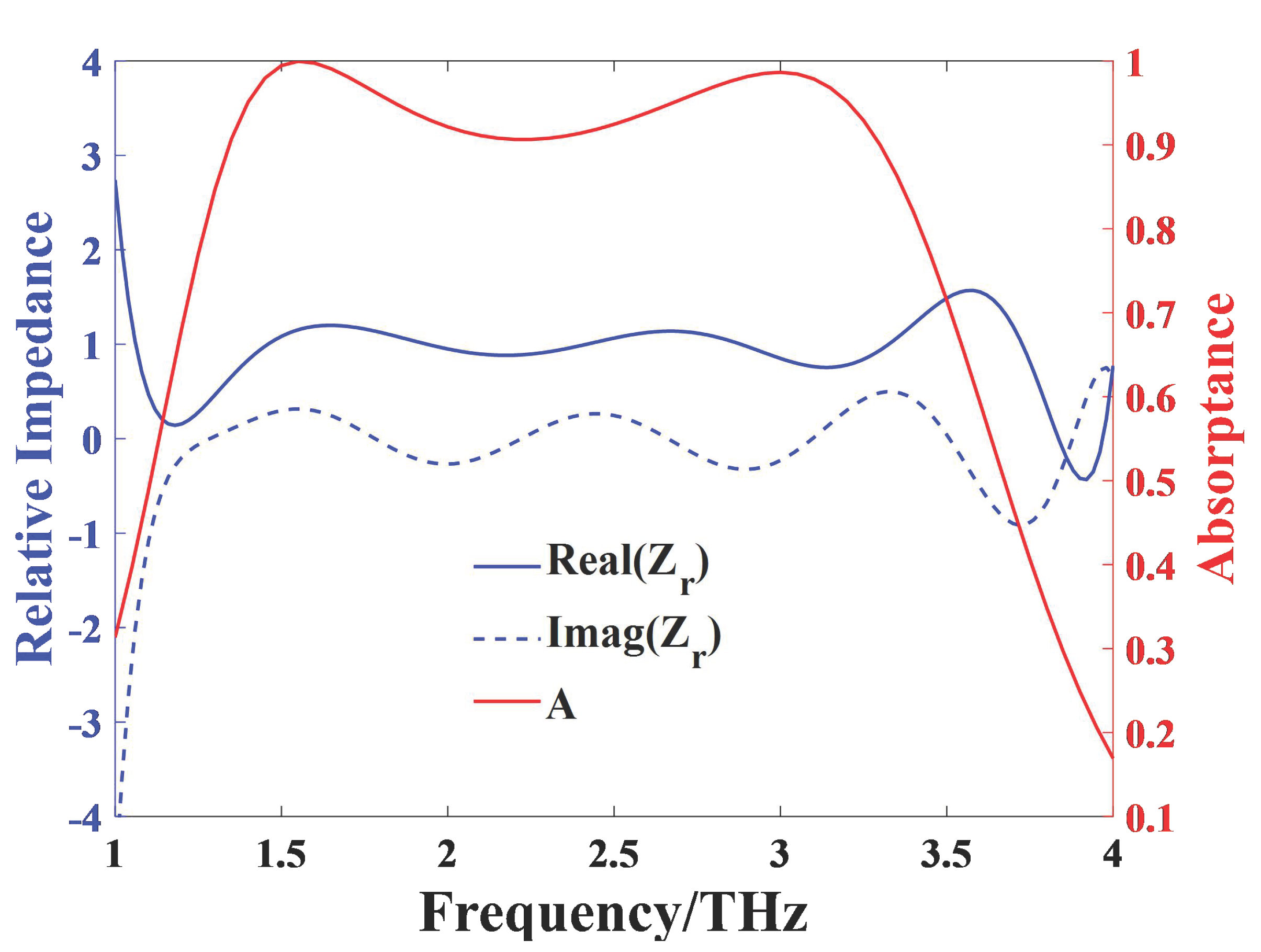
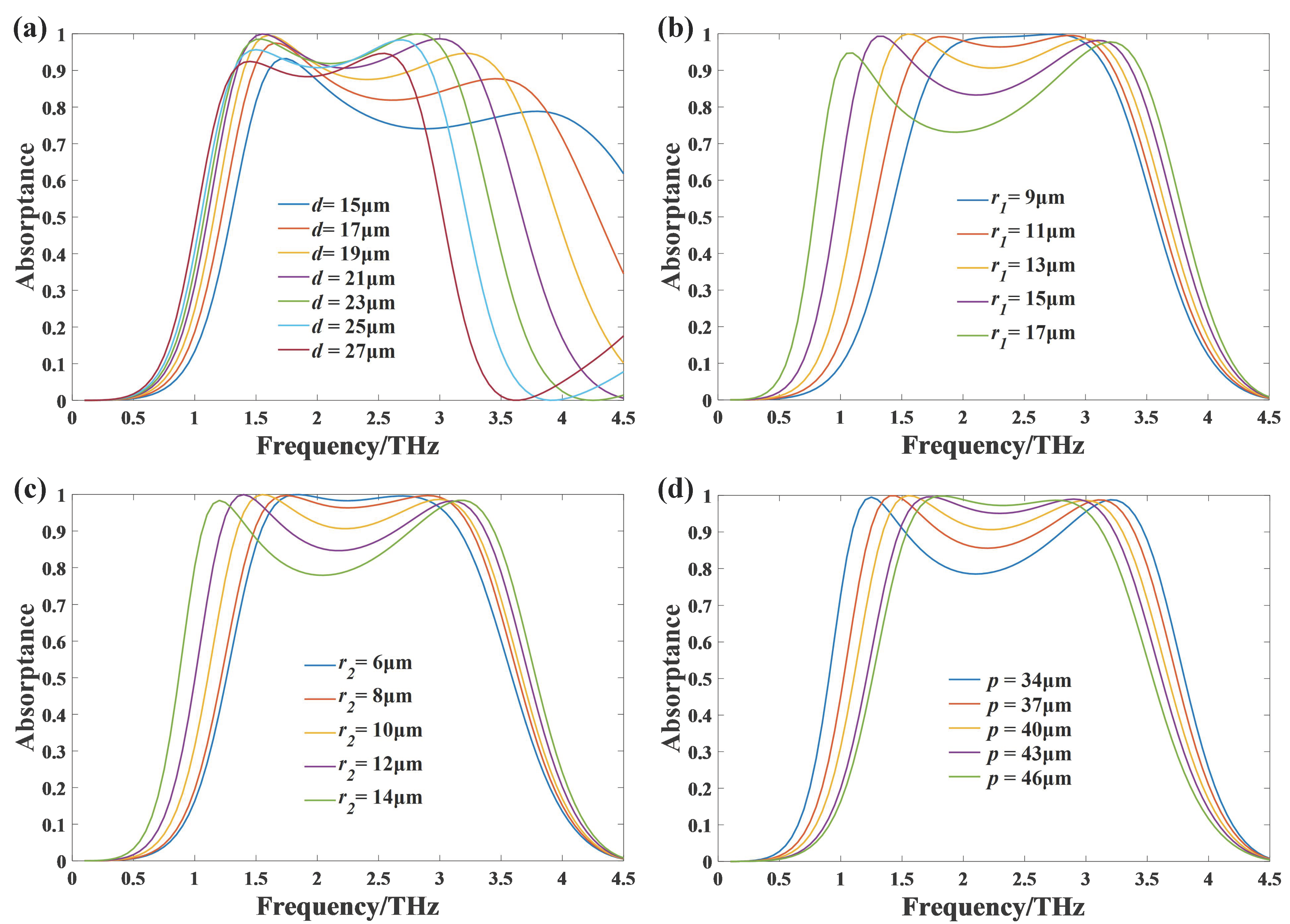

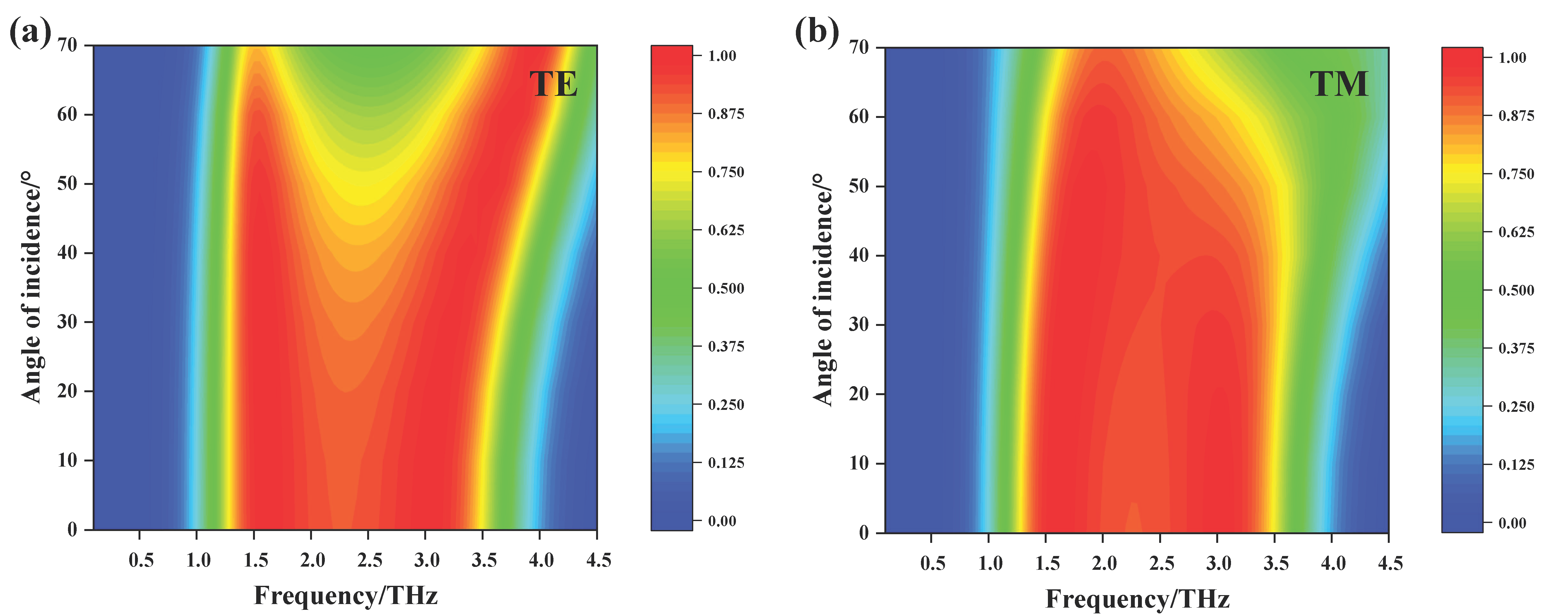
Publisher’s Note: MDPI stays neutral with regard to jurisdictional claims in published maps and institutional affiliations. |
© 2021 by the authors. Licensee MDPI, Basel, Switzerland. This article is an open access article distributed under the terms and conditions of the Creative Commons Attribution (CC BY) license (https://creativecommons.org/licenses/by/4.0/).
Share and Cite
Qian, J.; Zhou, J.; Zhu, Z.; Ge, Z.; Wu, S.; Liu, X.; Yi, J. Polarization-Insensitive Broadband THz Absorber Based on Circular Graphene Patches. Nanomaterials 2021, 11, 2709. https://doi.org/10.3390/nano11102709
Qian J, Zhou J, Zhu Z, Ge Z, Wu S, Liu X, Yi J. Polarization-Insensitive Broadband THz Absorber Based on Circular Graphene Patches. Nanomaterials. 2021; 11(10):2709. https://doi.org/10.3390/nano11102709
Chicago/Turabian StyleQian, Jiajia, Jun Zhou, Zheng Zhu, Zhenzhen Ge, Shuting Wu, Xiaoming Liu, and Jian Yi. 2021. "Polarization-Insensitive Broadband THz Absorber Based on Circular Graphene Patches" Nanomaterials 11, no. 10: 2709. https://doi.org/10.3390/nano11102709
APA StyleQian, J., Zhou, J., Zhu, Z., Ge, Z., Wu, S., Liu, X., & Yi, J. (2021). Polarization-Insensitive Broadband THz Absorber Based on Circular Graphene Patches. Nanomaterials, 11(10), 2709. https://doi.org/10.3390/nano11102709






